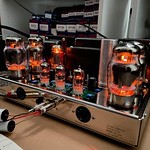 by Tube Nube Tue May 03, 2016 6:57 pm
by Tube Nube Tue May 03, 2016 6:57 pm
You note concern about degrading the signal going to the main speakers, but you didn't ask if there is a way to actually improve it. The answer(s) are, yes, you can set up these powered sub woofers to work with your system, and yes, you can do it without degrading the mains, and yes, you can actually enhance the performance of the mains.
One option that I recommend against is feeding both the ST 70 and the Sub plate amps through the cross over that's built into your sub woofers. In theory, that is an elegant way to go, because you're subs probably let you choose your high pass frequency (for the mains). That should make it easy to dial in your whole system. Easy, yes, but in my case, the cross over in my (Rhythmik) subs sucked the life out of the sound going into the ST 70.
So, instead, I fed the subwoofers (their built in amps) from one pre-amp out put, and fed the ST 70 with the other. If only one pre amp output, then using a y-splitter does the same thing.
This worked well, and it's what I'm back to doing now, but only because my current main speakers play down to about 40 Hz. I said you could improve on the mains performance, and with my last speakers that dropped off below 100Hz, here's what I did.
I constructed a simple 1st order high pass filter (consisting of a single bipolar capacitor in each line) going between the pre amp and the ST 70. This relieves the ST 70 of the burden of trying to deliver low frequencies the mains couldn't really cope with anyway. Unburdened with the heavy lifting of these low frequencies, the ST 70 was expected to have a much easier time dealing with the frequency range it was designated to handle. Supposedly, a livelier sound results. I can't say I really noticed it, but it was probably there.
At the speaker end of the equation, doppler distortion is reduced, because you don't have the speaker cones flapping in and out with those low frequencies they can't really handle anyway.
So two kinds of distortion are being reduced - doppler distortion (at the speaker) and transient intermodulation distortion (iirc) from the amp.
If you have a sound pressure level reading microphone, determine at what frequency your Royds fall off by 3dB. Make that your cross over frequency, and dial in your subwoofers accordingly. Then calculate the capacitor value needed for your mains high pass (capacitor). The formula is:
Fc = 1/2piRC
Where Fc is Cross over Frequency.
R is input impedance of your ST 70 (270,000 ohms, if I recall)
C is the capacitor value.





